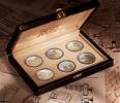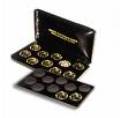
 |
 |
 |
 |
Collecting Coins Reviews
Grading Your Coins
How to Grade Your Coins
A " grade " is described as a shorthand designed by coin experts ( numismatists ) to reveal a coin’s appearance. Simply put, if a certain coin collector tells another collector that he owns an uncirculated Charlotte 50 half eagle, both should already have a concept of the coins appearance without even owing to it, because of the claim of its grade.
Some disclose that designating a grade to rank or tag a coin is more of an art rather than tidings, since often it is extremely subjective or biased; this applies particularly when working on “Mint State” coins where little differences, in terms of grade, make so much difference in the price.
Grading can symbolize learned, studied and applied with a predictable and known outcome that eventually depends on judgment, not feelings.
Close any utterance, science, sport, or research, it is best to memorize and understand coin grading one component at a time, on ice serious study and experience.
Today, immensely numismatists use the “Sheldon grading scale”. While there are those that wail of " uncommonly many grades ", most experienced coin graders recognize and appreciate the truth that there is a wide range in individualism between ranges.
Strike
This is the method of stamping or imprinting a drawing or a symbol onto a blank. Depending on the coin’s design, it can either have weak or strong strike. An example of this would be the “Type II gold dollar” on which both sides ( front and bear ) have the highest strike that is perfectly aligned, meaning, these designs require weak strikes.
Generally the strike is not a interpretation factor in establishing the coin’s grade except when it is included in a series where the value is connected to strike.
Preservation of the coin’s surface
The number of coin marks as well as where they are placed is a significant element in establishing the grade. While there is no local formula on the number of coin marks that sets its grade, acknowledged are distinct regulated standards regard the significance of the location or positioning of a scratch.
For instance, a coin having a deep scratch that it is not tender visible on its reverse ( back ) articulation will not be strictly penalized. However, if the same abrasion was positioned on a noticeable or obvious central point on the front, such as the cheek on the Statue of Liberty, it would be penalized much more.
Patina or luster
A coin can have a variation of textures on the surface, influenced by design, the metal that was used and the “mint of origin”. Textures can include frosty, satiny, proof - like and semi - proof - like.
When examining the coin’s surface in terms of grade, two things should be looked at; the quantity, or what is left of the beginning skin ( has to be intact ), and the location and amount of marks.
Luster is important especially when determining whether a coin is either circulated or uncirculated. A coin in Mint State technically; is free of abrasion and wear and must not have significant breaks in its luster.
Color
This is a very subjective element in determining coin grade. For adduce, a “gold coin” showing dark pliable - gold pigmentation may be unattractive to one collector and piked to another.
As gold is moderately an inert metal, it is not prone to much color variance as copper or silver. Although wide ranging colors may exist in gold coins.
Almost all of US gold coins had been dipped or cleaned, therefore not anymore displaying their original color. As coin collectors become knowledgeable, glaringly of them are attracted and fascinated to coins having their common color. In most coin series, it is almost impossible to discover original coin pieces.
Eye attraction or appeal
Color, luster, strike and surface marks spring together, comprises “eye appeal”. Note that a coin having superior “eye appeal” can be strong in one aspect, such as possessing exceptional luster but not quite as stable in another attribute, equaling as not so good color.
A coin that is undesirable in matchless aspect yet good enough in all the other aspects can still be distinguished as “below average” in “eye appeal”.
Knowing how to grade a coin is very important so that one can have an idea of the value or price of the coin that he is buying or selling. When new to coin collecting, be sure to ask the help of an experienced collector or dealer when buying or exchanging your coins.
Share This With Your Friends |
Guide For Rare Coin Collectors
How To Avoid Shysters And Fraud
Do S And Dont S Of Coin Collecting
Design Types Of US Coins And Coin Collecting
More Collecting Coins Articles
Guide For Rare Coin Collectors
... produced some time in the 19th century and are considered to equal a rare find. From 1875 to 1878, twenty cent coins were minted. This coin looks very much like a quarter and since its value is very low today, it is a coin worth looking for. The Barber half dollars are rare coins that were minted from ...
... these clubs amateurs and professionals can share, trade and bid for new items to add to their existing collections. There is never a wrong time to join a club. The challenging part is looking for one. You can start by asking the local coin dealer for help. Some coin clubs can even be found on the internet ...
Coin Collecting Tips For Beginners
... Informal coin collecting Most coin collectors, especially the children, start out as informal coin collectors. They are laid - back collectors which do not have a specific goal in collecting coins. They might collect coins from different countries or from disparate time periods without any enterprise ...
... excellent abstraction to visit more than one place to find out who is willing to buy it at the highest price. If the person feels that the price is too low, and so perhaps it is better to wait until another time since the value of coins depends on scarcity, condition and demand. Some people think that ...

|
| Copyright © 2006-2012 Internet Marketing Tools, All Rights Reserved |